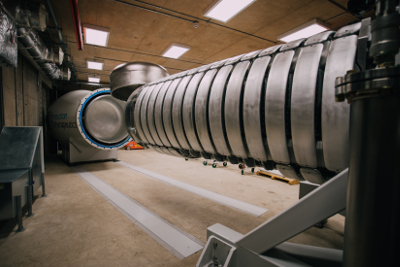 The High Flux Accelerator-Driven Neutron Facility supports the study of neutron interactions in materials for the nuclear sector, ranging from fission to fusion. In particular, this facility offers a broader programme relating to the understanding of neutron interactions with materials with applications extending to nuclear medicine and space.
The High Flux Accelerator-Driven Neutron Facility supports the study of neutron interactions in materials for the nuclear sector, ranging from fission to fusion. In particular, this facility offers a broader programme relating to the understanding of neutron interactions with materials with applications extending to nuclear medicine and space.
 Based at the University of Birmingham, this is the first UK neutron facility capable of providing fluxes for the characterisation of degradation of materials in the reactor periphery. It is also the first UK facility that possess a dual beam ion facility capable of providing the necessary fluxes to easily simulate the damage incurred by highly irradiated components such as cladding in current generation plant or structural materials in Gen IV or Fusion reactors. The high flux proton/deuteron beam can also create neutrons through the interaction with a high-power target.
Based at the University of Birmingham, this is the first UK neutron facility capable of providing fluxes for the characterisation of degradation of materials in the reactor periphery. It is also the first UK facility that possess a dual beam ion facility capable of providing the necessary fluxes to easily simulate the damage incurred by highly irradiated components such as cladding in current generation plant or structural materials in Gen IV or Fusion reactors. The high flux proton/deuteron beam can also create neutrons through the interaction with a high-power target.

The irradiation capability of this facility will combine with the existing high-energy light-ion accelerator to create a single UK user irradiation facility, creating the most intense accelerator driven neutron source worldwide.
For the University of Birmingham, this new facility has creared a new international research capability, an opportunity to collaborate in more programmes on a national and international scale and train a new generation of researchers in state-of-the-art techniques.

There are also opportunities to develop a wider community which draws in those interested in fundamental nuclear physics, cancer therapy (e.g. BNCT), development of high-power targets and radiobiology.
Accelerator maximum proton current and energy: >30mA DC / 2.6 MeV.
- 100kW beam dump for tuning at full beam current.
- Designed for continuous operation aiming for uptime > 95% between service intervals
- Initial guaranteed neutron yield > 2.5e13 primary neutrons
- Neutron target performance maintained for >250 hours at full power with <10% yield loss.
Explore the facility
Impact on research
This new neutron facility supports key research that underpins the nuclear fission and fusion. Research into reactor materials and neutron sensors underpins the Government’s clean energy and carbon emission targets. The thematic research areas that such a facility would underpin include:
Nuclear materials
In order to develop next generation nuclear reactors and better validate the life-expectancy of current generation reactors, understanding the materials degradation under neutron irradiation is important. There has been a tendency to rely on the use of protons as a surrogate for neutrons, but the validity of such studies is questionable. The present facility is targeted at materials and systems which lie beyond the reactor pressure vessel, i.e. not fuels. Beyond the civil nuclear applications, this facility would support research associated with the UK nuclear defence programme.
Nuclear fission and fusion data
The measurement of a series of key reactions, many involving neutron capture with higher energy neutrons, lies as part of the challenge for a more precise understanding of the nuclear processes associated with both fusion and fission.
Nuclear waste management
The safe storage of nuclear waste requires a detailed understanding of the effects of nuclear radiations on the storage media (e.g. glass and ceramics for fission products) in order to understand the long-term effects of radiation on the materials characteristics.
High power targets
The development of many new facilities such as accelerator driven subcritical reactors, or next generation spallation sources face development challenges around target design. The proposed facility would allow a UK base for such developments.
Medical physics
Understanding the radiobiology of neutron interactions is also very important from cancer therapy to the effect of nuclear radiation from industrial, medical and space environments. Neutrons are used in a range of medical applications, but boron neutron capture therapy is a promising area, which has been developed initially in the UK and has potential clinical deployment opportunities.
Nuclear metrology
The availability of a well-calibrated and controllable neutron source will be useful for nuclear metrology and the testing of new radiation monitoring systems, while also opening up the opportunity for the development and characterisation of new radiopharmaceuticals.
Nuclear physics
Neutron capture reactions are an important tool in nuclear spectroscopy, and nuclear astrophysics particularly in mapping the s-process paths close to the valley of stability – the key to understanding the synthesis path of heavier elements is being able to accurately determine both the spectroscopy and the neutron capture rate. The spectrum of neutrons produced will be very close to that in stellar environments.
Training for new users
Having these unique facilities on the University of Birmingham Campus offers unique training opportunities. This is across the spectrum from accelerator science, materials science and irradiation, management of high radiation environments and applied nuclear science. The type of skills and training that a hands-on facility can provide will allow researchers to be active players in the operation and future development of other international facilities and their programmes.